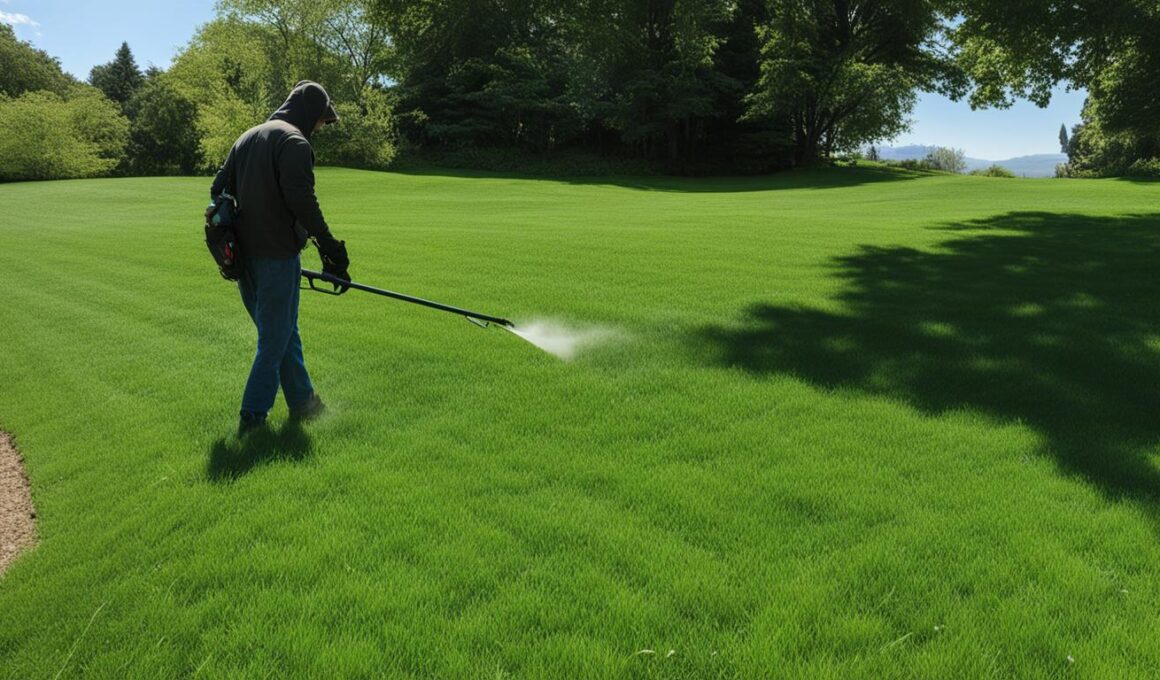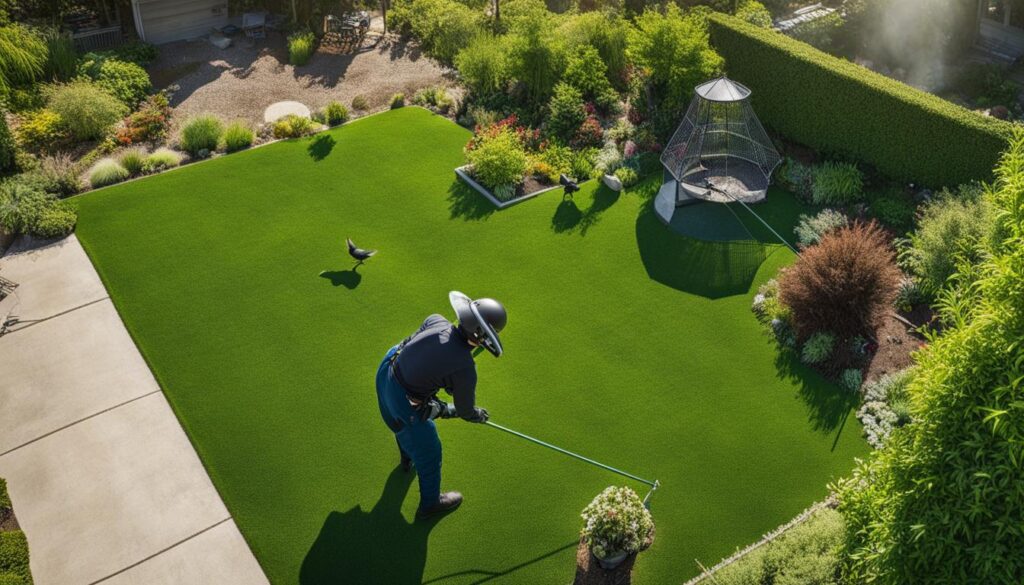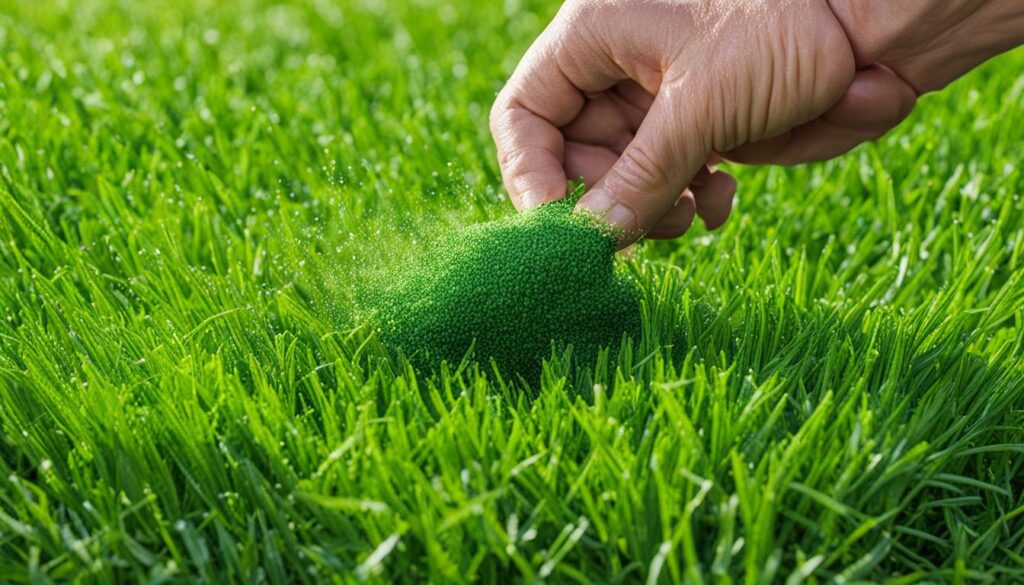If you’re looking for a time-saving solution to keep your lawn beautiful and weed-free, weed and feed is the way to go. This innovative lawn care product combines a broadleaf herbicide with a complete fertilizer to tackle weeds and nourish your grass at the same time. In this guide, we’ll walk you through the steps of applying weed and feed effectively, ensuring a healthy and thriving lawn.
Key Takeaways:
- Apply weed and feed to a slightly wet lawn in the spring when weeds start popping up.
- Apply weed and feed in the fall if necessary, with at least two months between applications.
- Mow your lawn at least twice before applying weed and feed to new lawns or freshly planted grass seed.
- Consider whether you need both the herbicide and fertilizer components or just an herbicide for specific weeds.
- Avoid feeding warm-season lawns late in the fall to prevent winterkill.
- Use a broadcast spreader to apply weed and feed uniformly across the lawn.
- Wait for two to four days before watering your lawn after applying weed and feed.
Considerations When Using Weed and Feed
Before using weed and feed, it is important to consider several factors. First, assess whether you actually need both the herbicide and fertilizer components. If your grass is already healthy and green, you may only need to use an herbicide to target specific weeds.
Secondly, it is crucial to avoid feeding warm-season lawns late in the fall to prevent winterkill. Applying fertilizer during this time can stimulate new growth, making the grass more susceptible to frost damage. It is best to consult lawn care experts or refer to the product label for specific guidance on whether or not to use weed and feed.
In addition, consider the specific needs of your lawn. Some grass types may require different approaches when it comes to herbicide and fertilizer applications. For example, if you have a cool-season grass lawn, your herbicide and fertilizer needs may differ from those with warm-season grass.
By carefully considering these factors, you can make informed decisions regarding using weed and feed and tailor your lawn care routine to meet the specific needs of your grass.
How to Apply Weed and Feed
When it comes to applying weed and feed to your lawn, there are a few important steps to follow to ensure optimal results. By using the right tools and techniques, you can effectively control weeds and provide essential nutrients to your grass. Here are some application tips to help you get started:
- Mow your lawn: It is recommended to mow your lawn two to four days before applying weed and feed. This will help create an even surface and allow the product to reach the soil more effectively.
- Follow manufacturer’s guidelines: Always refer to the manufacturer’s instructions for the recommended application rate. Each product may have specific guidelines based on the type of grass and weed infestation.
- Use a broadcast spreader: To ensure uniform coverage, it is best to use a broadcast spreader. This tool will help distribute the weed and feed granules evenly across the lawn.
- Apply in a crosshatch pattern: When using a spreader, make two passes in a crosshatch pattern to ensure thorough coverage. This will help target areas that may have been missed during the first pass.
- Avoid spreading into unwanted areas: Take care to avoid spreading the weed and feed granules into flower beds, vegetable gardens, or ornamental shrubbery. This will prevent any potential damage to desired plants.
- Wait before watering: After application, it is important to wait two to four days before watering your lawn. This allows the granules to dissolve and the product to penetrate the soil.
By following these application tips, you can achieve a more effective and efficient weed and feed treatment for your lawn, helping you achieve a healthy and vibrant outdoor space.
Safety Considerations When Using Weed and Feed
When using weed and feed, safety should be your top priority. By following these safety considerations, you can ensure a safe and effective application:
- Protective Clothing: Wear long pants, long sleeves, closed-toed shoes, and gloves during the application to prevent skin irritation. This will help shield your body from any potential contact with the product.
- Avoid Eye Contact: It is important to avoid getting the weed and feed product into your eyes. If any dust or particles come into contact with your eyes, flush them immediately with water.
- Ingestion Hazard: Keep weed and feed out of the reach of children and pets. Ingestion of the product can be harmful or even fatal. Store it in a secure place where it cannot be accessed by curious hands or paws.
- Pet Safety: Ensure that pets are kept away from the treated area until the product is thoroughly watered and the granules are dissolved. This will prevent them from coming into direct contact with the weed and feed.
By following these safety precautions, you can protect yourself, others, and your pets from potential harm. Safety should always be a priority when using any lawn care product.
What Is Weed and Feed?
Weed and feed is a lawn care product that combines an herbicide, typically targeting broadleaf weeds, with a fertilizer. The herbicide component of weed and feed is designed to target common broadleaf weeds such as dandelions, broadleaf plantain, chickweed, and dollar weed. It effectively kills these unwanted plants, allowing your lawn to thrive.
Alongside the herbicide, weed and feed also contains a fertilizer component. The fertilizer provides essential nutrients like nitrogen, phosphorous, and potassium to promote a healthy and vibrant lawn. These nutrients help the grass grow lush and green, providing a strong foundation for your outdoor space.
It is important to keep in mind that weed and feed may not be effective in controlling grassy weeds such as crabgrass. Additional treatments might be necessary if you’re dealing with these types of weeds. Consider consulting a professional or checking the product label for further guidance.
Pre-Emergent Vs. Post-Emergent Weed & Feed
When it comes to controlling and managing weeds in your lawn, understanding the difference between pre-emergent and post-emergent weed and feed is crucial. Each type of weed and feed serves a specific purpose in maintaining a beautiful and weed-free lawn.
Pre-emergent weed and feed is applied before weeds have sprouted, targeting their growth at the early stages. This type of weed and feed contains herbicides that create a barrier in the soil, preventing weed seeds from germinating and emerging from the ground.
Post-emergent weed and feed is designed to control existing weeds that have already emerged in your lawn. This type of weed and feed contains herbicides that specifically target and kill a wide range of common weeds, such as dandelions, crabgrass, and clover.
The choice between pre-emergent and post-emergent weed and feed depends on the type of weeds present in your lawn and the timing of application. Pre-emergent weed and feed is ideal for preventing weed growth and should be applied after the first frost, usually in early spring or fall. On the other hand, post-emergent weed and feed is effective for controlling existing weeds and should be applied when the weeds are actively growing, typically during warmer months.
By understanding the benefits and applications of both pre-emergent and post-emergent weed and feed, you can effectively manage weed control in your lawn and promote a healthier, more vibrant landscape.
Conclusion
Applying weed and feed correctly is essential in achieving a beautiful and healthy lawn. By following the proper application guidelines and considering the right timing and frequency, you can effectively control weeds and provide essential nutrients to your grass.
It is crucial to prioritize safety when using weed and feed. Always wear protective clothing, such as long pants, long sleeves, closed-toed shoes, and gloves, to prevent any skin irritation. Keep the product out of the reach of children and pets, as ingestion can be harmful.
Remember to read the product label and follow the instructions provided by the manufacturers for best results. By following lawn care tips like proper weed and feed application, you can enjoy a vibrant and lush lawn that will make your neighbors envious. Here’s to achieving the lawn of your dreams!
Can I Use Zoysia Grass Fertilizer in Conjunction with Weed and Feed for Lawn Care?
Yes, you can use top zoysia grass fertilizers in conjunction with weed and feed for lawn care. The key is to carefully follow the instructions on both products to ensure they work in harmony. By using the right combination, you can achieve a healthy, lush lawn while also effectively controlling weeds.
FAQ
How should I apply weed and feed?
To apply weed and feed, it is recommended to mow your lawn two to four days before application and follow the manufacturer’s guidelines for the recommended application rate. It is best to use a broadcast spreader to apply the product uniformly across the lawn, making two passes in a crosshatch pattern. Care should also be taken to avoid spreading the granules into flower beds, vegetable gardens, or ornamental shrubbery. After application, it is important to wait two to four days before watering the lawn.
What should I consider when using weed and feed?
Before using weed and feed, it is important to consider whether you actually need both the herbicide and fertilizer components. If your grass is already healthy and green, you may only need to use an herbicide to target specific weeds. Additionally, you should avoid feeding warm-season lawns late in the fall to prevent winterkill. It is best to consult an expert or refer to the product label for specific guidance on whether or not to use weed and feed.
What is weed and feed?
Weed and feed is a lawn care product that combines an herbicide, typically targeting broadleaf weeds, with a fertilizer. The herbicide component is designed to target weeds like dandelions, broadleaf plantain, chickweed, and dollar weed, while the fertilizer component provides nutrients such as nitrogen, phosphorous, and potassium to promote a healthy lawn. It is important to note that weed and feed may not kill crabgrass and other grassy weeds, so additional treatments may be necessary.
How do pre-emergent and post-emergent weed and feed differ?
Pre-emergent weed and feed is applied before weeds have sprouted to prevent their growth, while post-emergent weed and feed is used to control existing weeds. Pre-emergent weed and feed should be applied after the first frost, while post-emergent weed and feed should be applied when weeds are actively growing. The choice between these two types depends on the type of weeds in your lawn and the timing of application.
What safety considerations should I keep in mind when using weed and feed?
It is important to prioritize safety when using weed and feed. Protective clothing, such as long pants, long sleeves, closed-toed shoes, and gloves, should be worn during application to prevent skin irritation. Contact with eyes should be avoided, and if product dust gets into the eyes, they should be flushed with water. Weed and feed should be kept out of the reach of children and pets, as ingestion can be harmful or fatal. It is also important to keep children and pets off the lawn until the product is thoroughly watered and the granules are dissolved.
How can I achieve a beautiful lawn with weed and feed application?
By following the proper application guidelines, considering the right timing and frequency, and prioritizing safety, you can effectively control weeds and provide essential nutrients to your grass. Remember to always read the product label and follow manufacturers’ instructions for the best results.











